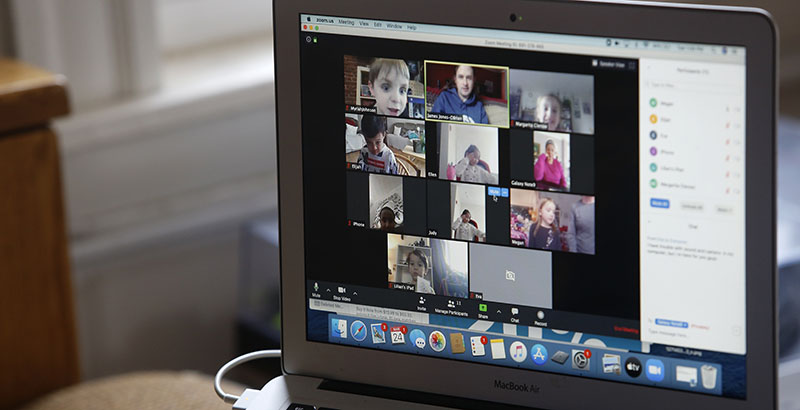A Teacher’s View: Remote Teaching Doesn’t Feel Like Teaching. Six Steps Toward Putting the Nuance Back Into Classroom Interactions

In any normal year, when I ask teachers, “What’s school like this year?” they talk about whiteboards, desks, school buses and the cafeteria.
This is not a normal year. And the answers to this question are no longer normal.
The truth is that school is absolutely nothing like what it used to be.
Back in the Before Days, school was a relatable topic. Everyone’s been to school. Therefore, everyone knows what school is like. There’s a teacher. There are desks. In November, there are handprint turkeys on the bulletin board. If the class is lucky, there’s a guinea pig munching away on a roll of toilet paper in the corner.
But this year, for many teachers, there is none of that. This is extremely liberating in one way, and extremely exhausting in numerous others.
The liberating thing is that teachers are fully and completely independent. There’s no student interrupting the class halfway through the period. There is no one accessing the classroom unannounced (thank you, Zoom waiting room!). There’s no fire drill, no intercom announcements from the vice principal, no broken heater.
The most important benefit is something that only teachers can relate to: There’s no variation to the daily schedule. No stragglers after class. No one entering the classroom minutes early. No one unwrapping the foil from their Chipotle burrito because the cafeteria was overwhelming and she just wanted to be alone.
There’s even time for bathroom breaks. The ultimate gift, right?
In the remote classroom, when teachers end class, they hit the red “Leave Meeting” button. What happens next sounds like what a full stop would sound like if a full stop could make a sound. The classroom is literally frozen closed. Not a molecule of life remains.
All this sounds like a dream come true. It’s teaching without interruption, with hard stops and focused time on and off.
But I’ll let you in on a little secret that non-teachers might not be privy to.
Remote teaching does not feel like teaching.
This is not the same as saying remote teaching is not teaching. It absolutely is. But something is distinctly lacking in remote teaching. That something is nuance.
Nuance is depth. When we teach, we are visually engaging our students. We are modulating our voices. We are scanning the classroom for body language and other nonverbal cues about our students’ individual well-being. We are temperature-taking, improvising, ad-libbing and re-creating. All. The. Time.
All this nuance-based activity adds up to the soul of teaching. And it is something that remote teaching largely lacks.
Teachers might design incredible Google slides, create endless interactive projects and podcast the classroom’s own Lincoln/Douglas debate for the world to hear.
But without In Real Life teaching, the relational magic is compromised. Not impossibly, not indelibly, but significantly.
Because that student who’s eating lunch alone in your classroom has something to say as she bites into her chicken burrito, looking down at her feet. And it has nothing to do with your award-winning lesson plan. That group of students lingering in the doorway to get your attention is not doing it because it’s the cool place to hang out on campus. That colleague is not slowing down her hallway walk as she approaches your classroom door just because her Fitbit told her to.
So when we wish for a swift and complete eradication of this pandemic, we wish for a return to our calling’s humanity, soul and nuance. Here are some simple tips for virtually replicating that nuance:
- Arrive 10 to 15 minutes early to your online class and use that time to meet 1:1 with students. Once students know that you’re regularly in the classroom, those with questions will arrive early, hoping to be let in before class.
- Open breakout rooms to one person in each so you can float in and out and have 1:1 discussions. This allows for strategic connection time with specific students.
- Allow for a “Video Off Day,” so students can learn without the added stress of seeing themselves in a square all the time.
- Hold open office hours during lunch. Even if it’s just once every two weeks, this allows for small groups to visit and unwrap their burrito foil together.
- Be the last to leave the classroom to allow for stragglers to initiate conversation. Encourage waving goodbye at the end of every class and wait to “leave meeting” until the very last student has exited.
- Use the chat function. Chat is an incredible tool, when used wisely.
Nat Damon, a 25-year educator and author of Time to Teach: Time to Reach, is executive director of Reach Academics. His podcast, “Reach Teach Talk,” is available on iTunes, Spotify and YouTube. He works on strengthening relationships within schools in the U.S. and U.K.
Get stories like these delivered straight to your inbox. Sign up for The 74 Newsletter

;)